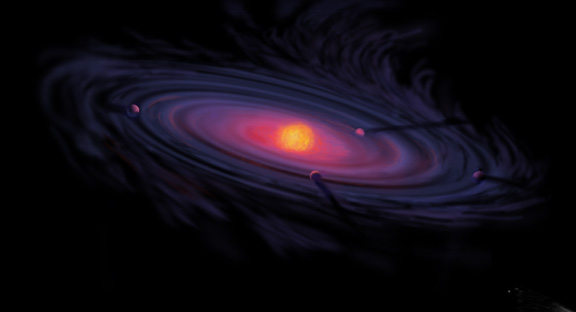Venus remains high in the evening sky this month. Look in the west at dusk for the brightest thing there. Venus was at greatest elongation on March 24, meaning that Venus is as far from the Sun as it can possible get in our sky. What’s more, at this time of year the ecliptic—the apparent path of the planets, Sun, and Moon—is almost at a right angle to the horizon at dusk. Thus, when Venus has an elongation this time of year, the full apparent distance from the Sun becomes height in the sky at dusk. That’s why Venus is so high at nightfall this month, setting over two hours after sunset.

Mars is higher in the morning sky each day this month. Look low in the southeast at dawn as Mars pulls away from Jupiter and Saturn. Mars also continues to brighten, surpassing Saturn in brightness by April 11 (Jupiter remains much brighter than Mars or Saturn, though.
Jupiter is slightly higher the morning sky each day this month. Look low in the southeast at dawn, especially towards the end of the month.
Saturn is also in the morning sky. Look about 5.5 degrees to the left of Jupiter.
April is the last month to see the full set of brilliant winter stars which now fill the western evening sky. Dazzling Orion is in the southwest at dusk. His three-starred belt is halfway between reddish Betelgeuse and bluish Rigel. Orion’s belt points rightward to Aldebaran in Taurus the Bull. To Orion’s upper left are the twin stars Castor and Pollux, marking the heads of Gemini, the Twins. You can find Sirius, the brightest star we ever see at night, by drawing a line from Orion’s belt towards the left. Forming a triangle with Sirius and Betelgeuse is Procyon, the Little Dog Star.
Joining the winter stars are stars of spring rising in the east. Ursa Major, the Great Bear, which includes the Big Dipper, is high above the North Star on spring evenings. Extend the Big Dipper’s handle to ‘Arc to Arcturus’ and then ‘speed on to Spica’. Look for Leo, the Lion high in the sky at dusk. There are fewer bright stars in this direction because of where the plane of our galaxy is in the sky. The area of sky between Gemini and Taurus and over Orion’s head is the galactic anticenter, which means that we face directly away from the galactic center when we look in this direction. Those bright winter stars setting in the west are the stars in our galactic arm, right behind the Sun. On the other hand, if you look at the sky between Ursa Major, Leo, Virgo, and Bootes, you’re looking straight up out of the galactic plane, towards the galactic pole. There are fewer bright stars in this direction.

Moon Phases in April 2020:
1st Quarter April 1, 5:21 a.m., April 30, 3:38 pm
Full April 7, 9:35 p.m.
Last Quarter April 14, 5:56 p.m.
New April 22, 9:26 p.m.
Sunday, April 12, is the the first Sunday after the first Full Moon after the first day of spring. That’s why this is Easter Sunday.
Though the doors of The George Observatory and other HMNS facilities are closed, our virtual doors remain open. Finding ways to creatively bring science to you is our highest priority. Your contributions matter today more than ever, as we strive to ensure that the museum is ready and able to welcome you back. Please GIVE TODAY to help support our mission of science education.
Clear Skies!







